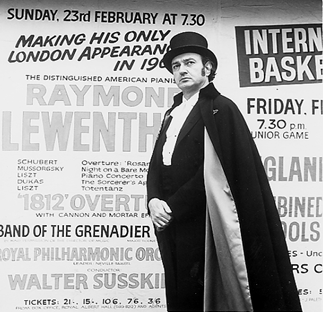Room 55--A giant of the keyboard
Charles Valentin-Alkan was born in 1813 and died in 1888. He was one of music history’s real loons but he did compose some astonishing keyboard music. He was a child prodigy and entered the Paris Conservatory at the age of six! Although he rarely performed in public he was known as one of the greatest piano talents of the 19th century. Liszt commented that he had the most perfect technique he had ever seen.
 Henri Valentin-Alkan showing off his best side
Henri Valentin-Alkan showing off his best side
There are many stories about Alkan, including that he and his brother lived in an apartment and kept an ape in the household (??). He was a scholar of the Bible and the Talmud throughout his life, and he evidently translated the Old and New Testaments into French. During his life he was also a player of the pedal piano, an instrument that also contained a pedal keyboard for the feet. The other apocryphal story about the composer was that he died ater he was crushed by a bookcase from which he was trying to retrieve a copy of the Talmud. It seems more likely that he was crushed by a heavy coat rack.
The music he composed was some of the most challenging ever written, for example in the work titled “Quasi-Faust,” there is a nine-voiced fugue in the middle of it.
 The great Raymond
The great Raymond
One of the few pianists to successfully perform Alkan in public was the Texas-born pianist Raymond Lewenthal. Born in 1923, a graduate of Julliard and a brilliant career ahead of him, it all came to a halt in 1953 when he was set upon by a bunch of young thugs, resulting in many broken bones in his hands and arms. He did not re-surface for ten years, but now he was a much more powerful artist who specialized in neglected composers such as Alkan, Goetz, von Henselt, Scharwenka, and others. He died in 1988.
Fortunately, there are others who have performed Alkan quite nicely. For example, Bernard Ringeissen. Here are two examples of the challenges set forth by Alkan. The first is the Etude in A-flat, which begins with legato (smooth connecting) notes in the left hand and staccato (short detached) notes in the right. Then the roles reverse and at the end, both hands are asked to play staccato and legato simultaneously.
Listen!
Perhaps more challenging is the Etude in E which unfolds in a fast 10/16 meter.
Listen!
Return to classroom second floor..
Return to classroom first floor..
If you need to leave, Go to initial page of site.
If you are interested in advertising a music-related business in the pages of the classroom, please send us an e-mail regarding rates by clicking here.
 Henri Valentin-Alkan showing off his best side
Henri Valentin-Alkan showing off his best side Henri Valentin-Alkan showing off his best side
Henri Valentin-Alkan showing off his best side The great Raymond
The great Raymond